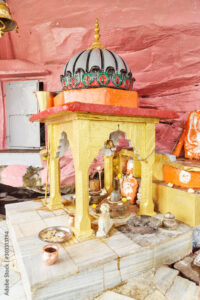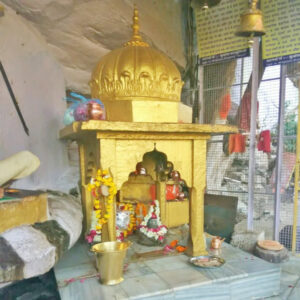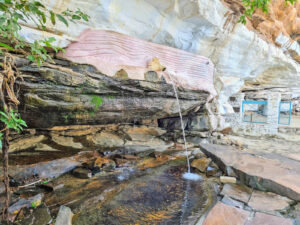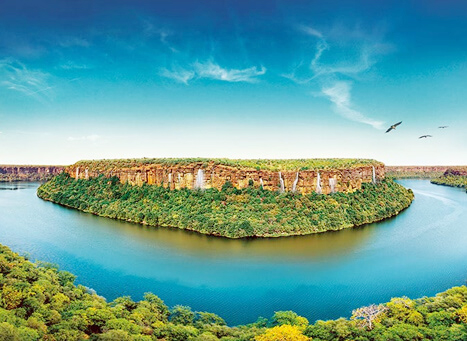In the heart of Rajasthan, amidst the arid landscape that characterizes the region, lies a hidden gem that transcends the boundaries of religious significance to embrace a unique blend of spirituality and natural splendor. The Garadia Mahadev Temple, perched on the cliffs of the Chambal River, stands as a testament to the timeless connection between divinity and the awe-inspiring beauty of Mother Nature.
A Tapestry of Legends: Origins and Mythology
Garadia Mahadev Temple is not merely a place of worship; it is a living testament to the rich tapestry of mythology that weaves through the Indian subcontinent. According to local legends, Lord Shiva, the Hindu deity of destruction and regeneration, chose this breathtaking locale as his abode for meditation. The word “Garadia” itself is derived from the Sanskrit word “Garadh,” meaning eagle, as the place is believed to have been a favored spot for Garuda, the mythical eagle mount of Lord Vishnu.
As the story goes, Lord Shiva, in his cosmic dance of Tandava, chose this picturesque setting to perform the Ananda Tandava, the dance of bliss. The temple, built in devotion to Lord Shiva, thus became a sacred space where devotees from far and wide seek divine blessings.
Architectural Marvel Amidst Wilderness
The temple itself is a marvel of ancient Indian architecture, seamlessly blending with the natural grandeur that surrounds it. Carved out of the rugged rocks that form the cliffs, the temple is a humble yet powerful structure. The intricate stone carvings narrate tales from Hindu mythology, depicting various deities and celestial beings.
The main sanctum, dedicated to Lord Shiva, houses a sacred Shiva Linga, the phallic symbol representing the cosmic energy. Devotees and tourists alike are captivated not only by the spiritual aura but also by the breathtaking panoramic views of the Chambal River and the ravines that stretch endlessly into the horizon.


The Spiritual Sojourn: Pilgrimage and Festivals
Garadia Mahadev Temple holds a significant place in the hearts of pilgrims who embark on a spiritual sojourn to seek blessings and enlightenment. The temple witnesses an influx of devotees, especially during the auspicious occasion of Mahashivaratri, a festival dedicated to Lord Shiva. On this day, the temple resonates with the rhythmic chants of prayers, the fragrance of incense, and the vibrant colors of offerings.

The pilgrimage to Garadia Mahadev is not just about religious rituals; it is a journey that encourages introspection and self-discovery. The serenity of the surroundings and the rhythmic flow of the Chambal River create an atmosphere conducive to meditation and contemplation.
Nature’s Symphony: A Symphony of Sounds and Sights
What sets Garadia Mahadev Temple apart is not just its religious significance but its harmonious integration with the natural landscape. As one stands on the temple cliffs, a breathtaking panorama unfolds. The Chambal River meanders through the ravines, creating a visual masterpiece that captures the essence of untouched wilderness.
The temple’s location also makes it a haven for bird watchers and nature enthusiasts. The cliffs provide a vantage point for observing the rich avian diversity, with eagles soaring high above and a myriad of other bird species adding to the symphony of nature.
Conservation and Community Involvement
Preserving the pristine beauty of Garadia Mahadev and its surroundings is essential for sustaining its spiritual and ecological significance. Local communities actively participate in initiatives aimed at conserving the natural habitat and maintaining the temple premises. Sustainable tourism practices are encouraged to strike a balance between human presence and environmental preservation.
The temple’s custodians work hand in hand with environmentalists and government authorities to ensure that the delicate ecosystem remains intact. By promoting awareness and responsible tourism, they seek to protect the unique flora and fauna that call the Chambal ravines home.
Beyond Boundaries: Garadia Mahadev in Modern Times
In the age of rapid urbanization and technological advancement, Garadia Mahadev Temple stands as a beacon, reminding us of the eternal connection between humanity and nature. The temple has become more than a religious site; it is a cultural and heritage landmark that draws people from diverse backgrounds.
Artists, writers, and photographers find inspiration in the timeless beauty that surrounds Garadia Mahadev. Its magnetic pull extends beyond religious boundaries, attracting visitors seeking solace, artistic inspiration, or simply a retreat into the lap of nature.
Conclusion: A Journey of the Soul
Garadia Mahadev Temple is more than an architectural wonder or a religious sanctuary; it is a journey of the soul. The spiritual energy that permeates the temple, coupled with the awe-inspiring natural beauty, creates an experience that transcends the mundane. It beckons travelers to embark on a quest for self-discovery, inviting them to witness the dance of divinity amidst the cliffs and the river.
As we stand on the sacred grounds of Garadia Mahadev, we are reminded that there are places where the earthly and the divine converge, where legends come to life, and where the spirit finds solace in the embrace of nature. It is a pilgrimage not just for the devout but for anyone seeking a profound connection with the cosmic rhythm that echoes through the ravines, making Garadia Mahadev Temple an enduring testament to the timeless dance of existence.























